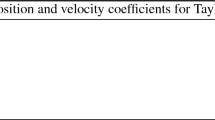Abstract
Lambert’s theorem states that for the two-body orbit determination problem, there is a particular value of the semimajor axis associated with a single conic transfer arc that will uniquely satisfy the initial conditions, which include the transfer time, the two ordered position vectors and the gravitational constant. The associated Lagrange equations for the orbital transfer time are expressed as series expansions for all cases. Many techniques exist to solve the Lagrange equations, but series solutions avoid the need for root finding and therefore they may allow for direct analytical optimization for mission design. Because of the case dependence, several different solution approaches are necessary among the three distinct forms of the series equations. Two new series solutions are given for each boundary of the long-way orbital case, which are also combined with an earlier result for hyperbolic and short-way transfers. Convergence properties of the new series solutions are investigated numerically for several examples.
Similar content being viewed by others
References
BATTIN, R. H. An Introduction to the Mathematics and Methods of Astrodynamics, New York: American Institute of Aeronautics and Astronautics, Inc., 1987, pp. 213–215, 325–341.
GOODING, R. H. “A Procedure for the Solution of Lambert’s Orbital Boundary-Value Problem,” Celestial Mechanics and Dynamical Astronomy, Vol. 48, 1990, pp. 145–165.
VALLADO, D. A. Fundamentals of Astrodynamics and Applications, Second Edition, Microcosm Press, El Segundo, California, 2001, pp. 452–454.
THORNE, J. D. and BAIN, R. D. “Series Reversion/Inversion of Lambert’s Time Function,” The Journal of the Astronautical Sciences, Vol. 43, July–September 1995, pp. 277–287.
ANDREWS, L. C. Special Functions for Engineers and Applied Mathematicians, New York: Macmillan Publishing Company, 1985, pp. 276–277.
THORNE, J. D. Series Reversion/Inversion of Lambert’s Time Function, (Master’s Thesis) Wright-Patterson AFB, Ohio: Air Force Institute of Technology Library, 1989, pp. 5–8.
ESCOBAL, P. R. Methods of Orbit Determination, Robert E. Krieger Publishing Company, 1965, pp. 188–197.
Author information
Authors and Affiliations
Corresponding author
Rights and permissions
About this article
Cite this article
Thorne, J.D. Lambert’s Theorem—A Complete Series Solution. J of Astronaut Sci 52, 441–454 (2004). https://doi.org/10.1007/BF03546411
Published:
Issue Date:
DOI: https://doi.org/10.1007/BF03546411




